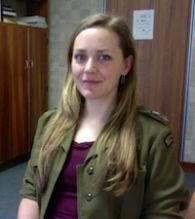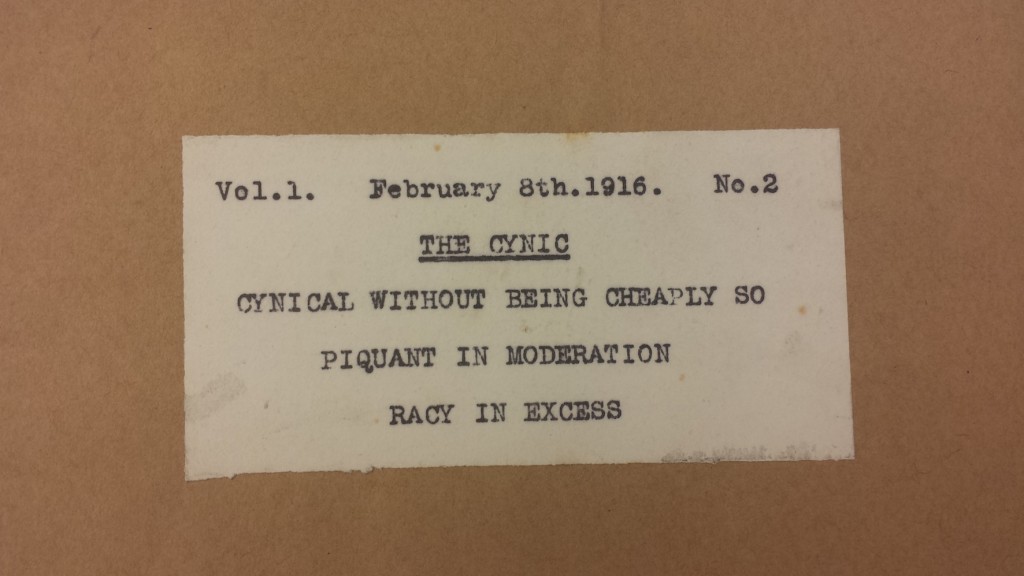 The following guest post is kindly supplied by Andrew W. Mellon fellow Dr Naomi Milthorpe.
The following guest post is kindly supplied by Andrew W. Mellon fellow Dr Naomi Milthorpe.
In early December 2015 I took up a Research Fellowship at the Huntington Library in California, to work on a project rather ambitiously titled “Waugh and the Library.” Having spent time researching Waugh’s writing and book collecting using the archives at the Harry Ransom Center, the British Library, Boston College Library and Georgetown Special Collections, I am fascinated by the relationship between these distinguished research libraries and their Waugh collections. How does each collection illuminate a different aspect of Waugh? Why is it that Waugh is such a fascinating figure for the archivist? Did Waugh consciously work to construct his own archival legacy? I’m not sure I’m ready to answer those questions yet, but I’ll continue to ponder them over the manuscripts in the Huntington’s Ahmanson Reading Room (and outside in the Californian sunshine).
The Huntington’s 2011 acquisition of a number of manuscript and rare materials relating to Evelyn Waugh, the result of a generous gift from Waugh collectors Loren and Frances Rothschild, adds greatly to our understanding of Waugh at various stages of his career. As John Howard Wilson said upon the announcement of the Rothschild’s gift, the acquisition makes the Huntington’s collection the “second leading center of Waugh studies” in the world (“Huntington Acquires Significant Collection”). Today I’m writing about one of Evelyn Waugh’s earliest literary productions held in the collection, The Cynic.
From the age of 10 to 14 (September 1910 to Easter 1917), Evelyn Waugh attended Heath Mount School in Hampstead. In Chapter Four of A Little Learning Waugh recalls his prep school fondly – but acerbically – as “the best school in the neighbourhood” though “not notably efficient” (80-81). During 1916 one of his hobbies was editing a magazine, The Cynic, with his friend Derek Hooper.

The Cynic Vol.1 No 2.: “Cynical Without Being Cheaply So. Piquant in Moderation. Racy in Excess.” Box 1(2), Evelyn Waugh Papers, The Huntington Library, San Marino, California. Image by author.
Readers may not have seen an edition of this publication – subtitled “Cynical Without Being Cheaply So Piquant in Moderation Racy in Excess” – or be familiar with its tone and humour (Waugh later summarized it as “flippant”). This rare item in Waugh’s early corpus is, for its 40-odd pages of the full run, extremely valuable. In 1992 the complete run was bought at Christie’s for £2,420, while in 2013 the second number was estimated for sale by Chiswick Auctions for £500-£800.
In Evelyn Waugh, Apprentice, Robert Murray Davis discusses Waugh’s “bellicose” editorship of The Cynic, which as Davis diagnoses typified Waugh’s “[d]esire for conflict” (3). According to Martin Stannard, at Heath Mount Waugh was the “leader of the school bullies” (41). In his diary Waugh gloried in the prospect of “smash[ing] the ramparts of convention” with his literary “shell” (qtd in Hastings 43). The Cynic hardly seems as radical as the young Waugh hopes, but it is defiant of official authority, which perhaps prefigures the iconoclasm of Decline and Fall. In A Little Learning Waugh recalled the magazine as “flippant rather than cynical; the few jokes that are now intelligible seem very feeble.” (94) Selina Hastings suggests that a dominating literary influence here might be Saki, to whom Waugh has been introduced earlier in his school career by one of his favourite masters, the English teacher Mr Ensor (42).
The Cynic offers its intended audience jokes, gossip, commentary on school life and on current events. As Waugh suggests, many of the jokes are feeble, though some still speak to the current reader. For example, in the section titled “SCHOOL GOSSIP” the editors report that “Owing to the War bread has got very expensive so we have been forced to use what has been left in the safe since 1910 in case of emergency.” (Box 1.2, 6) The well-known privations of public school here mingle with the more widespread shortages caused by the Great War; yet Waugh and Hooper use the opportunity to make fun of it.
Perhaps the most enjoyable piece of writing is the “DIARY OF A PRIZE MEDAL” (Box1.2, 3), which A Bibliography of Evelyn Waugh reports as authored by Waugh (27). This short vignette recalls 18th and 19th century “it-narratives” or novels of circulation, prose fictions written from the perspective of inanimate objects such as Talbot Baines Reed’s 1881 Boys’ Own series Adventures of a Three-Guinea Watch (Waugh owned an omnibus edition, now held in the Harry Ransom Center). Waugh’s Prize Medal is short enough to reproduce in full; readers of Waugh’s own diary might find the dull, occasionally melodramatic prosaism of this piece familiar.
Wednesday: – My case was opened and I was given to a boy.
He did not seem a bit pleased to see me.
Was given in to be engraved.
Next year: – Have been engraved and returned to boy.
Friday: – On the way to school the boy tried to pass me as a penny. He did not succeed.
Saturday: – I am getting rusty! What is to be done. [end p4]
Sunday: – Alas! Alack! the rust increases!
Monday: – Boy was very angry to find I did not fit into a chocolate slot.
Tuesday: – Boy begins carpentry. I am not used.
Wednesday: – I am no use here. In Germany I should have been a shell long ago – I am going to commit suicide.
Thursday: – I have got stuck in the glue and am being melted. – Farewell! (Box1.2, 3)
The Cynic thus prompts some smiles and a few questions, the biggest of which is Waugh’s co-editor. Hooper is something of a mystery. As Waugh writes in A Little Learning, he “lost touch” with his friends from Heath Mount; none had “risen to power” or to notoriety (90). The 1992 Christie’s catalogue listing the complete run writes that Hooper “joined the Chinese Customs Service” after leaving school (“Sale 4791 Lot 386”). There is no DNB entry for Hooper, and little information on him in the Waugh biographies. Of course his name chimes with the feckless common man of Brideshead Revisited. Yet the schoolboy Waugh must have enjoyed Hooper’s company enough to collaborate on the five numbers of The Cynic, and the diary record offers a little more of the young Hooper. In 1916 Waugh records an encounter between himself, Hooper, and some “Street cads” which resulted in “wrestling and boxing [and] my victory” (9). Perhaps Waugh found in Hooper a sympathetically pugilistic fellow? After Heath Mount, Hooper attended Sherborne, where he had hopes of being made House Prefect (Diaries 47). In the December 1919 Waugh records an afternoon tea with “Dear old Hooper” and, the next day, going on a book hunt with him (47); in 1920 there are several entries noting the friendship continuing, with visits to tea chéz Hooper (100), excursions to the theatre (101), and invitations to Christmas charades (108). After 1920, however, the diary record dries up. Hooper’s account of their friendship and collaboration would indeed be an addition to our knowledge of Waugh’s school days and his developing literary vocation. I wonder if there are any readers out there who know what became of Derek Hooper?
The most interesting part of this number of The Cynic is an illustration which was included as prompt to a competition. Hooper and Waugh each jointly contributed to the illustration and the competition challenges readers to guess which artist drew which parts:
1st. Prize, set of Cigarette Cards, or Set of Stamps.
With this copy is found a special supplement which is the joint work of Waugh and Hooper. ALL YOU HAVE TO DO is to (a) send up your copy of the supplement with each figure marked with the initials you think drew it, and (b) if you do not want to mark the picture go up to either of the two artists and point out to them who drew which figures. (Box 1.2, 1-2)
The illustration, titled “Heath Mount BC 55”, depicts a group of cavemen in skins, holding clubs, many of whom are humorously styled with spectacles, or with well-groomed short beards.

“Heath Mount BC 55” by Waugh and Hooper, 1916. The Cynic, Box 1(2), Evelyn Waugh Papers, The Huntington Library, San Marino, California. Image by author.
One wonders if these are intended as caricature portraits of the Heath Mount masters, the joke being the schoolboy perennial that all masters are ancient.
Readers might enjoy the challenge set by Waugh and Hooper: which of these Edwardian Cro-Magnons was drawn by Waugh, do you think?
Naomi Milthorpe is Lecturer in English at the University of Tasmania and a 2015-16 Andrew W. Mellon Fellow at the Huntington Library. For details of the Huntington’s Fellowship programme click here.

 Subscribe to 's posts
Subscribe to 's posts
[…] can read more about the Huntington’s Evelyn Waugh collection in Evelyn Waugh, Cynic? and Manuscripts as Memorials by Naomi […]